
- SAP Community
- Products and Technology
- Technology
- Technology Blogs by Members
- Installation of SAP HANA Database with Extended Ap...
Technology Blogs by Members
Explore a vibrant mix of technical expertise, industry insights, and tech buzz in member blogs covering SAP products, technology, and events. Get in the mix!
Turn on suggestions
Auto-suggest helps you quickly narrow down your search results by suggesting possible matches as you type.
Showing results for
gorbenkoteh
Active Participant
Options
- Subscribe to RSS Feed
- Mark as New
- Mark as Read
- Bookmark
- Subscribe
- Printer Friendly Page
- Report Inappropriate Content
09-09-2020
3:30 PM
Intro
This blog-post continues a series of publications about the Installation of different SAP Systems in Yandex Cloud
In previous parts:
SAP HANA EXPRESS EDITION in Yandex Cloud. Binary Installation. Step-by-step guide
SAP NetWeaver AS ABAP Developer Edition 7.52 SP04 in Yandex Cloud. Binary Installation. Step-by-step guide
SAP NetWeaver AS ABAP Developer Edition 7.52 SP04 in Yandex Cloud. Binary Installation. Extended version on the Russian language
Resolution
Step 1. Media downloads
Go to the download page for SAP HANA, express edition
and if you do not have an account in SAP, you need to go through a simple registration.

Download and run SAP HANA Express Edition Download Manager (java app)


Download parameters:
Platform– Linux/x86 – 64
Image – Binary Installer
Package – Applications*
* - Applications means SAP HANA database, application server, and development environment SAP HANA Extended Application Services, Advanced Model (XSA)
Step 2. Create a virtual machine in Yandex Cloud
At this point we need a free soft:
PuTTY – SSH Client
PuTTYgen – Public/Private keys generator
WinSCP – SFTP client
or MobaXTerm as an alternative.
Let's create a Public-Private key bunch using PuTTYgen.
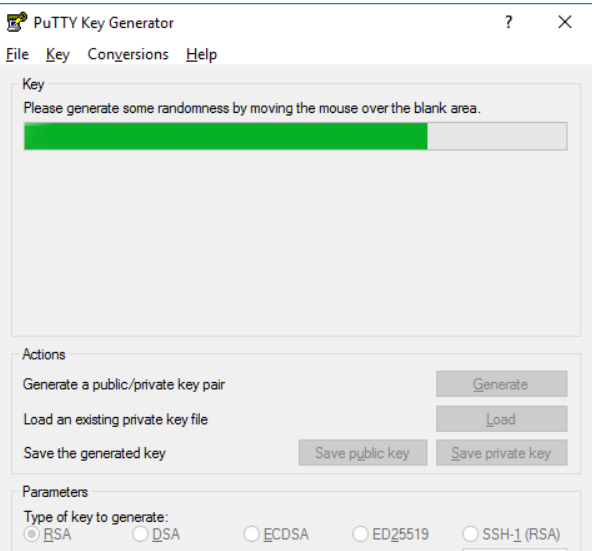
Register/Logon to Yandex Cloud (https://cloud.yandex.ru/). Go to the Compute Cloud section and start creating a virtual machine.

Virtual machine name: saphana2
Let's set the parameters of the VM. In the installation guide for SAP HANA Express Edition (Server + Application), we see the following recommended parameters:
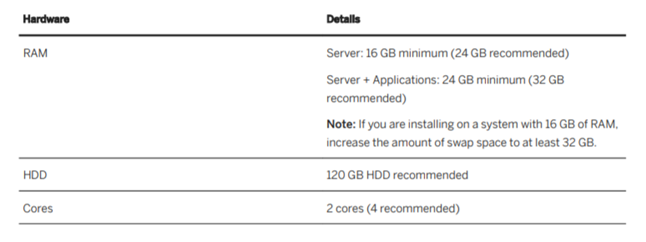
Parameters of the VM:
vCPU - 2,
RAM – 32GB,
15 GB + 150 GB, where
15 GB (boot - SSD)
150 GB (data - * HDD)
* - since SAP HANA all operations in RAM as a carrier for a snapshot of data, we can choose a slower HDD
As the operating system, we will choose the latest stable OpenSUSE OS, at the time of this blog-post writing, this is the OpenSUSE version 42.3

Specify the Login and Public SSH key generated using PuTTYgen

Step 3. Prepare virtual machine for SAP HANA XSA
Find your Public IPv4 address in the Overview-Network section.

Create an SSH connection in the Putty client with your Public IPv4 address and add a private key in the Auth section.

Let's prepare the file structure for installation.
lsblk

vda – boot, vdb – data.
SAP recommends the following file structure
/usr/sap + /usr/sap/distr – 35 GB
/hana/shared/data - 60 GB
/hana/shared/log - 10 GB
/hana/shared –40 GB

Let's implement such a structure using the fdisk utility:
fdisk /dev/vdb

Let's check the structure again and create an ext4 filesystem on all the created partitions:
lsblk
and
mkfs.ext4 /dev/vdb1
mkfs.ext4 /dev/vdb2
mkfs.ext4 /dev/vdb3
mkfs.ext4 /dev/vdb4

Let's create directories for distributions and an SAP HANA database, and also mount the sections created in the previous step to them. We will also update the /etc/fstab file so that the mount is restored on reboot.
mkdir /usr/sap
mkdir /hana
mkdir /hana/shared
mkdir /hana/shared/data
mkdir /hana/shared/log
mount /dev/vdb1 /usr/sap
mount /dev/vdb2 /hana/shared/data
mount /dev/vdb3 /hana/shared/log
mount /dev/vdb4 /hana/shared
mkdir /usr/sap/distr
vi /etc/fstab

Set the permission for the folder with the SAP installation files:
chmod -R 777 /usr/sap/distr
Let's import the settings from Putty into WinSCP. Connect to the VM and load the archives of SAP HANA Server (hxe.tgz), SAP HANA Extended Application Services –XSA (hxeesa.tgz), and shine.tgz (Training content) to /usr/sap/distr

Unpack the archives:
cd /usr/sap/distr
tar -xvzf hxe.tgz
tar -xvzf hxexsa.tgz
tar -xvzf shine.tgz
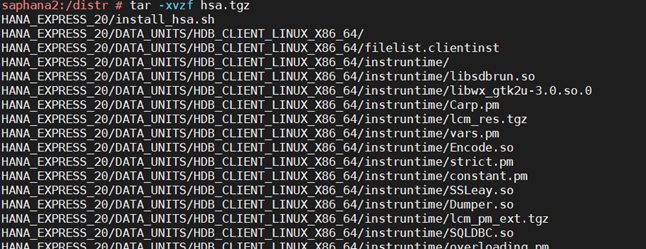
Add repository:
sudo zypper ar -c https://download.opensuse.org/tumbleweed/repo/oss/ openSUSE-Tumbleweed-Oss-HTTPS
Install required Linux libraries libstdc++, libnuma1, libatomic and libgcc_s1:
zypper install libstdc++6
zypper install libatomic1
zypper install libgcc_s1
zypper install libnuma1
Step 4. Install SAP HANA XSA
Execute the installation script from root user:
cd /usr/sap/distr
./setup_hxe.sh
Confirm that:
- Media files located in: /distr/HANA_EXPRESS_20
- SID: HXE
- Instance number: 90
- Component to install: all
all -
Application Function Library (AFL) with Analysis Library (PAL), Business Function Library (BFL), Optimization Function Library (OFL), plug-in SAP HANA EPM–MDS

Master password - password from <sid>adm user (hxeadm in our case) on OS-level and SYSTEM on DB-level

Installation processes...

SAP HANA Express Edition installed

During XSA installation you must provide master-password from XSA_ADMIN, XSA_DEV, TEL_ADMIN on XSA level

Step 5. Сheckup
Check that HANA DB up and running:
su – hxeadm
HDB info
Output example:

Check that HANA XSA is up and running.
Authorization:
xs-admin-login
User: XSA_ADMIN
Password: (Master password installed during installation)
Check the version for SAP HANA Extended Application Services, Advanced Model:
xs -v
Output example:

Check available buildpacks:
xs buildpacks
Output example (Python, Java, and Node.js buildpacks are available):

Check available runtimes:
xs runtimes
Output example (SAP JVM, Apache Tomcat, Node.js) runtimes are available
Step 6. Post-installation activity
Web development and administration tools of SAP HANA XSA requires editing hosts file
1. Open the Notepad from the name of the Administrator
2. Open the file C:\Windows\System32\drivers\etc\hosts in Notepad
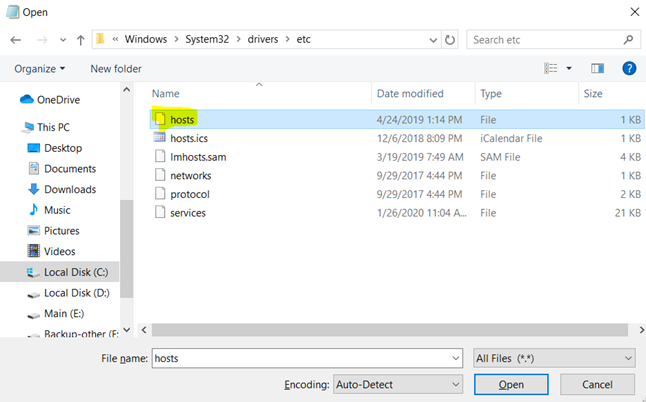
3. Add line
<Public IPv4 address in the Overview-Network section> <hostname>
Step 7. Beginning of work with XSA
There are several ways to administer and develop for SAP HANA XSA
Administer: SAP HANA Cockpit or Eclipse/HANA Studio (SAP HANA Administration Console Perspective)
Develop: SAP WebIDE or Eclipse/HANA Studio (SAP HANA Development Perspective)
Since HANA Cockpit and Web IDE were installed during the installation process, we will consider them as management and administration tools.
Get url for XSA-applications:
xs app xsa-cockpit --urls
xs app webide --urls
xs app cockpit-web-app --urls
Output example:

Let's open these URL's in the web browser...
XSA Cockpit:
XSA Cockpit is a browser-based application server management system SAP HANA Extended Application Services, Advanced Model.
XSA Cockpit lets you manage users and roles, organizations, and spaces.
In the User Management section, you can check and, if necessary, assign the roles DEVX_ADMINISTRATOR, DEVX_DEVELOPER for the XSA_DEV user.
In the Tenant Databases section, you can extend the XSA capabilities to a new tenant, in our case, HXE, and link the development space to it.


Hana Cockpit:
HANA Cockpit is an SAP HANA database management system.
The cockpit can be used to manage users and roles at the database level, to create backups, monitor performance, diagnose performance issues at the database level, and many other administrative tasks.
The script for registering database resources in HANA Cockpit is executed during installation, if the script for some reason has not been executed, it must be run manually before the first use by Cockpit.
su – hxeadm
/usr/sap/distr/HANA_EXPRESS_20/register_cockpit.sh


WebIDE:
WebIDE is a browser-based development environment integrated with GitHub.
In the Development section, you can develop, test, and publish modules in NodeJS, Java, HTML5.
In the Database Explorer section, you can create and manage objects at the database level (tables, views, stored procedures, etc.)
Output for connection to tenant and overview of objects in it:


Output example from CLI (state of WebIDE must be RUNNING)
xs app webide
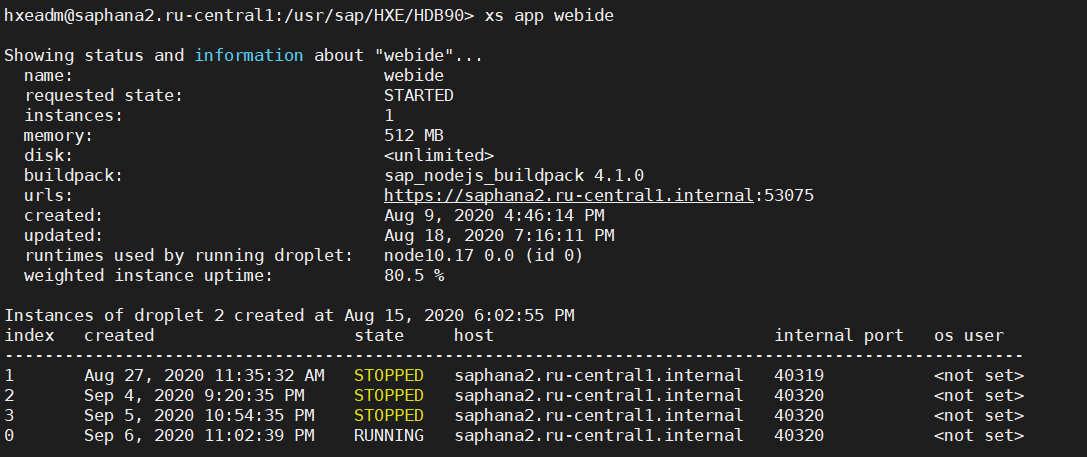
Step 8. First XSA app
Open WebIDE
Workspace - Git - Clone Repository
This is a simple "Hello World!" UI5/Node.js app. Small and easy for understanding.
Set development space
Project -Project Settings
Set Space to development:

Build UI5 application/ microservice
Build project
Consider folder mta_archives in the right pane
Select .mtar file and Deploy it to "Deploy to XS Advanced"
Space: development

Output must be:

Come back to XSA CLI and switсh to development space:
xs target -o HANAExpress -s development
xs apps

Open our app in the web browser.
Output must be:

Troubleshooting
Problem:
500 "Internal Server Error" for WebIDE or for any other XS APP
Resolution:
xs app webide
if instances in statuses stopped, crashed
to do:
xs delete-app-instances webide --stopped
xs delete-app-instances webide --crashed
xs start webide
Conclusion
This blog series will be continued
In the next part:
SAP HANA XS: Advanced example with DB access
Links:
Maintaining the SAP HANA XS Advanced Model Run Time
SAP HANA Network Requirements
Recommended File System Layout for SAP HANA
SAP WEB IDE for SAP HANA Installation. Troubleshooting Guide
- SAP Managed Tags:
- SAP HANA,
- SAP HANA, express edition,
- Basis Technology
You must be a registered user to add a comment. If you've already registered, sign in. Otherwise, register and sign in.
Labels in this area
-
"automatische backups"
1 -
"regelmäßige sicherung"
1 -
"TypeScript" "Development" "FeedBack"
1 -
505 Technology Updates 53
1 -
ABAP
14 -
ABAP API
1 -
ABAP CDS Views
2 -
ABAP CDS Views - BW Extraction
1 -
ABAP CDS Views - CDC (Change Data Capture)
1 -
ABAP class
2 -
ABAP Cloud
2 -
ABAP Development
5 -
ABAP in Eclipse
1 -
ABAP Platform Trial
1 -
ABAP Programming
2 -
abap technical
1 -
absl
1 -
access data from SAP Datasphere directly from Snowflake
1 -
Access data from SAP datasphere to Qliksense
1 -
Accrual
1 -
action
1 -
adapter modules
1 -
Addon
1 -
Adobe Document Services
1 -
ADS
1 -
ADS Config
1 -
ADS with ABAP
1 -
ADS with Java
1 -
ADT
2 -
Advance Shipping and Receiving
1 -
Advanced Event Mesh
3 -
AEM
1 -
AI
7 -
AI Launchpad
1 -
AI Projects
1 -
AIML
9 -
Alert in Sap analytical cloud
1 -
Amazon S3
1 -
Analytical Dataset
1 -
Analytical Model
1 -
Analytics
1 -
Analyze Workload Data
1 -
annotations
1 -
API
1 -
API and Integration
3 -
API Call
2 -
Application Architecture
1 -
Application Development
5 -
Application Development for SAP HANA Cloud
3 -
Applications and Business Processes (AP)
1 -
Artificial Intelligence
1 -
Artificial Intelligence (AI)
4 -
Artificial Intelligence (AI) 1 Business Trends 363 Business Trends 8 Digital Transformation with Cloud ERP (DT) 1 Event Information 462 Event Information 15 Expert Insights 114 Expert Insights 76 Life at SAP 418 Life at SAP 1 Product Updates 4
1 -
Artificial Intelligence (AI) blockchain Data & Analytics
1 -
Artificial Intelligence (AI) blockchain Data & Analytics Intelligent Enterprise
1 -
Artificial Intelligence (AI) blockchain Data & Analytics Intelligent Enterprise Oil Gas IoT Exploration Production
1 -
Artificial Intelligence (AI) blockchain Data & Analytics Intelligent Enterprise sustainability responsibility esg social compliance cybersecurity risk
1 -
ASE
1 -
ASR
2 -
ASUG
1 -
Attachments
1 -
Authorisations
1 -
Automating Processes
1 -
Automation
1 -
aws
2 -
Azure
1 -
Azure AI Studio
1 -
B2B Integration
1 -
Backorder Processing
1 -
Backup
1 -
Backup and Recovery
1 -
Backup schedule
1 -
BADI_MATERIAL_CHECK error message
1 -
Bank
1 -
BAS
1 -
basis
2 -
Basis Monitoring & Tcodes with Key notes
2 -
Batch Management
1 -
BDC
1 -
Best Practice
1 -
bitcoin
1 -
Blockchain
3 -
BOP in aATP
1 -
BOP Segments
1 -
BOP Strategies
1 -
BOP Variant
1 -
BPC
1 -
BPC LIVE
1 -
BTP
11 -
BTP Destination
2 -
Business AI
1 -
Business and IT Integration
1 -
Business application stu
1 -
Business Application Studio
1 -
Business Architecture
1 -
Business Communication Services
1 -
Business Continuity
1 -
Business Data Fabric
3 -
Business Partner
12 -
Business Partner Master Data
10 -
Business Technology Platform
2 -
Business Trends
1 -
CA
1 -
calculation view
1 -
CAP
3 -
Capgemini
1 -
CAPM
1 -
Catalyst for Efficiency: Revolutionizing SAP Integration Suite with Artificial Intelligence (AI) and
1 -
CCMS
2 -
CDQ
12 -
CDS
2 -
Cental Finance
1 -
Certificates
1 -
CFL
1 -
Change Management
1 -
chatbot
1 -
chatgpt
3 -
CL_SALV_TABLE
2 -
Class Runner
1 -
Classrunner
1 -
Cloud ALM Monitoring
1 -
Cloud ALM Operations
1 -
cloud connector
1 -
Cloud Extensibility
1 -
Cloud Foundry
4 -
Cloud Integration
6 -
Cloud Platform Integration
2 -
cloudalm
1 -
communication
1 -
Compensation Information Management
1 -
Compensation Management
1 -
Compliance
1 -
Compound Employee API
1 -
Configuration
1 -
Connectors
1 -
Consolidation Extension for SAP Analytics Cloud
1 -
Controller-Service-Repository pattern
1 -
Conversion
1 -
Cosine similarity
1 -
cryptocurrency
1 -
CSI
1 -
ctms
1 -
Custom chatbot
3 -
Custom Destination Service
1 -
custom fields
1 -
Customer Experience
1 -
Customer Journey
1 -
Customizing
1 -
cyber security
2 -
Data
1 -
Data & Analytics
1 -
Data Aging
1 -
Data Analytics
2 -
Data and Analytics (DA)
1 -
Data Archiving
1 -
Data Back-up
1 -
Data Governance
5 -
Data Integration
2 -
Data Quality
12 -
Data Quality Management
12 -
Data Synchronization
1 -
data transfer
1 -
Data Unleashed
1 -
Data Value
8 -
database tables
1 -
Datasphere
2 -
datenbanksicherung
1 -
dba cockpit
1 -
dbacockpit
1 -
Debugging
2 -
Delimiting Pay Components
1 -
Delta Integrations
1 -
Destination
3 -
Destination Service
1 -
Developer extensibility
1 -
Developing with SAP Integration Suite
1 -
Devops
1 -
digital transformation
1 -
Documentation
1 -
Dot Product
1 -
DQM
1 -
dump database
1 -
dump transaction
1 -
e-Invoice
1 -
E4H Conversion
1 -
Eclipse ADT ABAP Development Tools
2 -
edoc
1 -
edocument
1 -
ELA
1 -
Embedded Consolidation
1 -
Embedding
1 -
Embeddings
1 -
Employee Central
1 -
Employee Central Payroll
1 -
Employee Central Time Off
1 -
Employee Information
1 -
Employee Rehires
1 -
Enable Now
1 -
Enable now manager
1 -
endpoint
1 -
Enhancement Request
1 -
Enterprise Architecture
1 -
ETL Business Analytics with SAP Signavio
1 -
Euclidean distance
1 -
Event Dates
1 -
Event Driven Architecture
1 -
Event Mesh
2 -
Event Reason
1 -
EventBasedIntegration
1 -
EWM
1 -
EWM Outbound configuration
1 -
EWM-TM-Integration
1 -
Existing Event Changes
1 -
Expand
1 -
Expert
2 -
Expert Insights
1 -
Fiori
14 -
Fiori Elements
2 -
Fiori SAPUI5
12 -
Flask
1 -
Full Stack
8 -
Funds Management
1 -
General
1 -
Generative AI
1 -
Getting Started
1 -
GitHub
8 -
Grants Management
1 -
groovy
1 -
GTP
1 -
HANA
5 -
HANA Cloud
2 -
Hana Cloud Database Integration
2 -
HANA DB
1 -
HANA XS Advanced
1 -
Historical Events
1 -
home labs
1 -
HowTo
1 -
HR Data Management
1 -
html5
8 -
HTML5 Application
1 -
Identity cards validation
1 -
idm
1 -
Implementation
1 -
input parameter
1 -
instant payments
1 -
Integration
3 -
Integration Advisor
1 -
Integration Architecture
1 -
Integration Center
1 -
Integration Suite
1 -
intelligent enterprise
1 -
Java
1 -
job
1 -
Job Information Changes
1 -
Job-Related Events
1 -
Job_Event_Information
1 -
joule
4 -
Journal Entries
1 -
Just Ask
1 -
Kerberos for ABAP
8 -
Kerberos for JAVA
8 -
Launch Wizard
1 -
Learning Content
2 -
Life at SAP
1 -
lightning
1 -
Linear Regression SAP HANA Cloud
1 -
local tax regulations
1 -
LP
1 -
Machine Learning
2 -
Marketing
1 -
Master Data
3 -
Master Data Management
14 -
Maxdb
2 -
MDG
1 -
MDGM
1 -
MDM
1 -
Message box.
1 -
Messages on RF Device
1 -
Microservices Architecture
1 -
Microsoft Universal Print
1 -
Middleware Solutions
1 -
Migration
5 -
ML Model Development
1 -
Modeling in SAP HANA Cloud
8 -
Monitoring
3 -
MTA
1 -
Multi-Record Scenarios
1 -
Multiple Event Triggers
1 -
Neo
1 -
New Event Creation
1 -
New Feature
1 -
Newcomer
1 -
NodeJS
2 -
ODATA
2 -
OData APIs
1 -
odatav2
1 -
ODATAV4
1 -
ODBC
1 -
ODBC Connection
1 -
Onpremise
1 -
open source
2 -
OpenAI API
1 -
Oracle
1 -
PaPM
1 -
PaPM Dynamic Data Copy through Writer function
1 -
PaPM Remote Call
1 -
PAS-C01
1 -
Pay Component Management
1 -
PGP
1 -
Pickle
1 -
PLANNING ARCHITECTURE
1 -
Popup in Sap analytical cloud
1 -
PostgrSQL
1 -
POSTMAN
1 -
Process Automation
2 -
Product Updates
4 -
PSM
1 -
Public Cloud
1 -
Python
4 -
Qlik
1 -
Qualtrics
1 -
RAP
3 -
RAP BO
2 -
Record Deletion
1 -
Recovery
1 -
recurring payments
1 -
redeply
1 -
Release
1 -
Remote Consumption Model
1 -
Replication Flows
1 -
Research
1 -
Resilience
1 -
REST
1 -
REST API
1 -
Retagging Required
1 -
Risk
1 -
Rolling Kernel Switch
1 -
route
1 -
rules
1 -
S4 HANA
1 -
S4 HANA Cloud
1 -
S4 HANA On-Premise
1 -
S4HANA
3 -
S4HANA_OP_2023
2 -
SAC
10 -
SAC PLANNING
9 -
SAP
4 -
SAP ABAP
1 -
SAP Advanced Event Mesh
1 -
SAP AI Core
8 -
SAP AI Launchpad
8 -
SAP Analytic Cloud Compass
1 -
Sap Analytical Cloud
1 -
SAP Analytics Cloud
4 -
SAP Analytics Cloud for Consolidation
2 -
SAP Analytics Cloud Story
1 -
SAP analytics clouds
1 -
SAP BAS
1 -
SAP Basis
6 -
SAP BODS
1 -
SAP BODS certification.
1 -
SAP BTP
20 -
SAP BTP Build Work Zone
2 -
SAP BTP Cloud Foundry
5 -
SAP BTP Costing
1 -
SAP BTP CTMS
1 -
SAP BTP Innovation
1 -
SAP BTP Migration Tool
1 -
SAP BTP SDK IOS
1 -
SAP Build
11 -
SAP Build App
1 -
SAP Build apps
1 -
SAP Build CodeJam
1 -
SAP Build Process Automation
3 -
SAP Build work zone
10 -
SAP Business Objects Platform
1 -
SAP Business Technology
2 -
SAP Business Technology Platform (XP)
1 -
sap bw
1 -
SAP CAP
2 -
SAP CDC
1 -
SAP CDP
1 -
SAP CDS VIEW
1 -
SAP Certification
1 -
SAP Cloud ALM
4 -
SAP Cloud Application Programming Model
1 -
SAP Cloud Integration for Data Services
1 -
SAP cloud platform
8 -
SAP Companion
1 -
SAP CPI
3 -
SAP CPI (Cloud Platform Integration)
2 -
SAP CPI Discover tab
1 -
sap credential store
1 -
SAP Customer Data Cloud
1 -
SAP Customer Data Platform
1 -
SAP Data Intelligence
1 -
SAP Data Migration in Retail Industry
1 -
SAP Data Services
1 -
SAP DATABASE
1 -
SAP Dataspher to Non SAP BI tools
1 -
SAP Datasphere
9 -
SAP DRC
1 -
SAP EWM
1 -
SAP Fiori
2 -
SAP Fiori App Embedding
1 -
Sap Fiori Extension Project Using BAS
1 -
SAP GRC
1 -
SAP HANA
1 -
SAP HCM (Human Capital Management)
1 -
SAP HR Solutions
1 -
SAP IDM
1 -
SAP Integration Suite
9 -
SAP Integrations
4 -
SAP iRPA
2 -
SAP Learning Class
1 -
SAP Learning Hub
1 -
SAP Odata
2 -
SAP on Azure
1 -
SAP PartnerEdge
1 -
sap partners
1 -
SAP Password Reset
1 -
SAP PO Migration
1 -
SAP Prepackaged Content
1 -
SAP Process Automation
2 -
SAP Process Integration
2 -
SAP Process Orchestration
1 -
SAP S4HANA
2 -
SAP S4HANA Cloud
1 -
SAP S4HANA Cloud for Finance
1 -
SAP S4HANA Cloud private edition
1 -
SAP Sandbox
1 -
SAP STMS
1 -
SAP SuccessFactors
2 -
SAP SuccessFactors HXM Core
1 -
SAP Time
1 -
SAP TM
2 -
SAP Trading Partner Management
1 -
SAP UI5
1 -
SAP Upgrade
1 -
SAP Utilities
1 -
SAP-GUI
8 -
SAP_COM_0276
1 -
SAPBTP
1 -
SAPCPI
1 -
SAPEWM
1 -
sapmentors
1 -
saponaws
2 -
SAPS4HANA
1 -
SAPUI5
4 -
schedule
1 -
Secure Login Client Setup
8 -
security
9 -
Selenium Testing
1 -
SEN
1 -
SEN Manager
1 -
service
1 -
SET_CELL_TYPE
1 -
SET_CELL_TYPE_COLUMN
1 -
SFTP scenario
2 -
Simplex
1 -
Single Sign On
8 -
Singlesource
1 -
SKLearn
1 -
soap
1 -
Software Development
1 -
SOLMAN
1 -
solman 7.2
2 -
Solution Manager
3 -
sp_dumpdb
1 -
sp_dumptrans
1 -
SQL
1 -
sql script
1 -
SSL
8 -
SSO
8 -
Substring function
1 -
SuccessFactors
1 -
SuccessFactors Time Tracking
1 -
Sybase
1 -
system copy method
1 -
System owner
1 -
Table splitting
1 -
Tax Integration
1 -
Technical article
1 -
Technical articles
1 -
Technology Updates
1 -
Technology Updates
1 -
Technology_Updates
1 -
Threats
1 -
Time Collectors
1 -
Time Off
2 -
Tips and tricks
2 -
Tools
1 -
Trainings & Certifications
1 -
Transport in SAP BODS
1 -
Transport Management
1 -
TypeScript
2 -
unbind
1 -
Unified Customer Profile
1 -
UPB
1 -
Use of Parameters for Data Copy in PaPM
1 -
User Unlock
1 -
VA02
1 -
Validations
1 -
Vector Database
1 -
Vector Engine
1 -
Visual Studio Code
1 -
VSCode
1 -
Web SDK
1 -
work zone
1 -
workload
1 -
xsa
1 -
XSA Refresh
1
- « Previous
- Next »
Related Content
- New Machine Learning features in SAP HANA Cloud in Technology Blogs by SAP
- SAP Fiori Frontend 6.0 App installation and connection to SAP Business Suite in Technology Q&A
- FCO-00011 The step start with step key |NW_ABAP_OneHost|ind|ind|ind|ind|0|0|NW_Onehost_System|ind|i in Technology Q&A
- error during install SAP S/4HANA Server 2022 in Technology Q&A
- explore the business continuity recovery sap solutions on AWS DRS in Technology Blogs by Members
Top kudoed authors
| User | Count |
|---|---|
| 11 | |
| 10 | |
| 7 | |
| 6 | |
| 4 | |
| 4 | |
| 3 | |
| 3 | |
| 3 | |
| 3 |